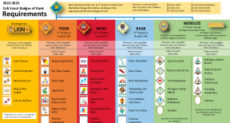 Making my way through fellow Scouters’ blogs, I’ve recently come across some interesting observations about Committee Chairs and their role in a unit.
Making my way through fellow Scouters’ blogs, I’ve recently come across some interesting observations about Committee Chairs and their role in a unit.
In some units (Troops and Packs), the Committee Chair is a figurehead position — a name filled in on the roster so that the charter will go through. Leader meetings are conducted by the Scoutmaster or Cubmaster. In other units, the Committee Chair exists only to call the monthly committee meetings and not much else.
But in reality, the Committee Chair’s job is, in many ways, the most important one in a unit.
For instance, take a look at the responsibilities of the Committee Chair, taken from the Troop Committee Guidebook:
- Organize the committee to see that all functions are delegated, coordinated, and completed.
- Maintain a close relationship with the chartered organization representative and the Scoutmaster.
- Interpret national and local policies to the troop.
- Prepare troop committee meeting agendas.
- Call, preside over, and promote attendance at monthly troop committee meetings and any special meetings that may be called.
- Ensure troop representation at monthly Roundtables.
- Secure top-notch, trained individuals for camp leadership.
- Arrange for charter review and recharter annually.
- Plan the charter presentation.
(Cub leaders will find information on the Pack Committee Chair’s job in the Cub Scout Leader Book.)
The number one job is to organize the committee and make sure that everything the committee is supposed to do gets done. Read further in the Troop Committee Guidebook to find out what the committee’s jobs are, and if you haven’t done so, take the Troop Committee Challenge training either in person or online to underscore your understanding of these important functions.
Sounds rather like the captain of a ship, doesn’t it?
The rest of the list provides supporting duties toward the end of overseeing committee functions. Of essential importance is the second. You must maintain an open and frequent line of communication with the Scoutmaster, for it is he or she who puts the program into motion. You are also the primary point of contact with your sponsor through the Chartered Organization Representative, who should be kept informed of unit activities and brought in on any matters involving policy or disputes. (Just as we expect the Scouts to try to resolve disputes themselves before seeking adult help, the committee needs to try hard to resolve matters internally before seeking help outside the unit.) This relationship is represented by one of the legs of the COR’s three-legged stool, the other two being the unit commissioner and the district professional, so without your support, the unit can be in trouble.
And as a ship’s captain needs to know the laws of the sea, Â so the Committee Chair needs to be intimately familiar with BSA and Council policy and procedures so he or she can interpret them to the unit committee and direct leaders. The prominent Scouting bloggers (listed to the right) remind us that whenever there is a question or a dispute, find and read the applicable BSA policy, whether it’s in the Scoutmaster Handbook, Troop Committee Guidebook, Cub Scout Leader Book, or any of the other supporting publications, and for local matters, to keep the Unit Commissioner and District Executive on speed-dial to get the authoritative word directly.
As important as the Scoutmaster or Cubmaster is, the Committee Chair is the one responsible for guiding the overall unit toward the goals of the program as put forth by the BSA.
Image: jscreationzs / FreeDigitalPhotos.net
This post first appeared on Bobwhite Blather.




I tend to think of the Scoutmaster as Captain. So that makes the committee chair the admiral. Here’s why I think that way.
The capatain is in charge of training his officers (PLC) and directing the ship. The captain is in charge of his troops (Scouts) through the officers(PLC) that he trains. He rarely interacts with enlisted men (Scouts) or lower ranking officers (APL, Scribe, etc).
The Admiral is in charge of the overall mission of the ship (Troop), providing personnel (committee members), funding the operation (treasury) and reporting to the political elements (district, council, etc).
I think this analogy works with people who are familiar with ships and the Navy. They understand when I ask how often an enlisted man hangs out with the captain? The understand when I ask how often the captain goes to a squad or enlisted man and gives him/her a direct order (not counting bridge crew obviously). The same is true in Scouting. The SM rarely interacts with, or hangs out with the Scouts or gives them direction. That’s their leader’s job (SPL/PL).